by Winding Pathways | Nov 3, 2022 | (Sub)Urban Homesteading, Chickens
Well, our Ninja Hen is at it again. A neighbor, watching the hens for us, entered the barn one morning to find the California White strutting around inside the barn but out of the coop! Looking around, our neighbor also found a small white egg in a depression in the sand in a tucked-away corner of the barn.
After some coaxing, Ninja Chicken hopped back into the coop through the door our neighbor had opened.
Reinforcing Didn’t Work
You may remember an earlier blog where we explained that Rich had blocked off all the areas he could see where she might be able to fly up to and escape into the barn. All was well for several weeks.
Meanwhile, Houdini Hen (aka Ninja Chicken) was figuring out how to “fly the coop” so to speak.
And she did. One morning, we too, found her again proudly prancing around the barn. She looked at us and seemed to say, “Haha. You can’t keep me in!” But, she could not quite figure out how to get back into the coop.
How in the world did she escape?
We looked around and found over in a far corner another gap between the chicken wire and the ceiling. The wire was bent down so we speculate that she worked at bending it when she landed on the wire and eventually had enough space to squeeze through and roam the barn at will laying eggs in that cozy little corner. The wire is straightened and the space is now plugged with plywood. Will she figure out another way to escape? We’ll know in the next few days.
Lesson
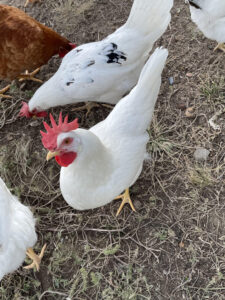
Our Ninja Chicken
This hen continues to teach us something. Chickens are not dumb clucks. This girl used intelligence to find an exit and demonstrated amazing athletic ability getting to and through a relatively small hole up high near the ceiling. And she is first in line for snacks, too.
by Winding Pathways | Oct 20, 2022 | (Sub)Urban Homesteading, Chickens, Garden/Yard
One of our 14 chickens is a true American Ninja Chicken. Most of us know the TV program American Ninja Warriors where athletes navigate extreme obstacles to beat the buzzer. Well, this gal, a California White, is right up there with the most athletic of them all.
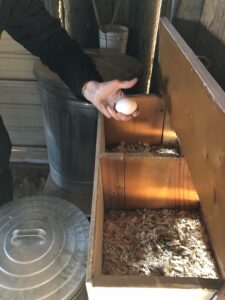
Our American Ninja Warrior Chicken begin to lay eggs at about 20 weeks.
Like most hens, when she reached about 20 weeks old, she laid her first egg in our coop. Then another a couple of days later. Then, none. And, none the next day. That’s unusual. When a hen starts laying, she’ll usually continue.
One evening, Rich counted the hens. There were 13. Hmmmm. Where’s the 14th? Had she met her fate? After recounting three times, checking the run, and scratching his head over this mystery, came a cluck from the attic of the barn. Could she have made the tortuous way up through the rafters into the barn’s attic? Naw. No chicken could do that. Then we remembered that another California White hen had laid eggs in the barn attic. So, Rich got the stepladder and checked anyway.
There she was up in the barn attic above the coop our second American Ninja Chicken proudly looking at her freshly laid egg.
Are Ninja Chickens Dumb Clucks? Not Really
A chicken myth is that they are dumb. Everyone “knows” that. Nope. Not true. To get into the attic our hen had to be both smart and athletic. Brains figured out a pathway through rafters, plywood, spools of wire, and stored items. Athleticism got her there. She negotiated an obstacle course like what we watch on TV’s American Ninja Warrior.
Once she reached the barn attic, she found the darkness and privacy hens appreciate when nesting. Unlike human ninjas,
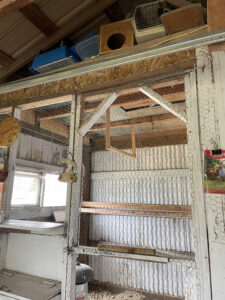
The American Ninja Warrior Chicken wormed her way to the barn attic.
there wasn’t a buzzer to ring when she got up there, but her clucks gave away her presence.
We admire her athleticism and smarts, but laying eggs up there won’t work. We need to easily collect them. So, we spent a morning plugging up any possible route to the attic.
We may have succeeded. Today’s egg was in the coop, but we’re certain she’s trying to figure out how to again reach the attic. She might outwit us.
When do Chickens Start Laying Eggs?
Female baby chicks usually start laying when they are 16 to 24 weeks old. Of the many breeds of chickens those that lay white eggs are relatively small, agile, and intelligent. They can worm their way into inaccessible places and fly like a pheasant. In contrast, most brown egg layers are heavy and cumbersome, and struggle just trying to get airborne.
Our American Ninja hen is a California White, a Leghorn hybrid. She’s small, fast, agile, and determined and lays white eggs – in the attic of the barn.
by Winding Pathways | Oct 13, 2022 | (Sub)Urban Homesteading
Home Upkeep!
From time to time, we post a blog about home care on Winding Pathways. Ways to upgrade appliances and refinish the structure. Although removed from our normal nature tips, home care is both important and interesting. One TV ad caught our attention about a low-maintenance polyaspartic garage floor. We checked it out and decided to pursue it.
Our realtor friends tell us that investing 3% to 5% of a home’s value annually for maintenance, modernization, and freshening helps the structure keep its market value. It also makes the house pleasant, safe, and efficient.
This year our improvements included replacing a 26-year-old furnace and a nearly as old air conditioner. Both were working but their age indicated possible failure, and we didn’t want the furnace to conk out on a 20 below Iowa night.
New Polyaspartic Garage Floor
Our garage needed attention. We noticed staining on the baseboards and the floor was, well, shabby. Likely installed in 1947 when the house was built the floor was old, pitted concrete. It was dusty and hard to sweep. Come winter the car brings in salt brine picked up on roads. It penetrates into the old concrete and is nearly impossible to remove.
This summer we hired the Hello Garage Company to install a floor of Polyaspartic. Before the workers came, we promised to remove the baseboards so they could apply the surface right up to the wall. While pulling off the baseboards we found a distressing problem.
Years of seeping moisture had caused the bottom sill to rot. Nothing was holding up part of the wall. Fortunately, the rest of the wall was in good condition but the rotted area needed attention before the Polyaspartic could be applied. It became a DIY project.
Preparing for the New Garage Floor
- Removed baseboards and trimmed the wallboard higher to expose vertical 2X4s.
- Removed all rotted wood, which actually looked like topsoil.
- Cut off the rotted bottoms of the vertical 2X4s.
- Replaced the rotted sill with pressure-treated lumber, using shims beneath the verticals to give the wall solid strength.
- Screwed strips of ½” plywood onto the new sill to enable attaching the baseboard.
- Painted the baseboards but left them in storage for a while.
- Repainted the entire garage and installed sideboards to protect the walls from car doors banging against them.
- Washed shelves and containers before putting them back.
Hello Garage workers then ground down the old concrete floor, removing many of the potholes and unevenness. They then applied the Polyaspartic. We let it cure for more than two full days before bringing in the car or walking on it.
The final part of the job was screwing in the old refurbished baseboards and re-setting the garage with the cleaned-off shelves and containers. The garage looks great. Here are the before and after photos.
-
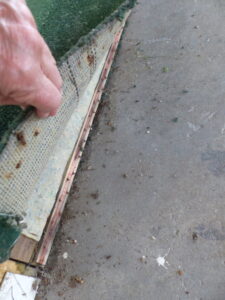
-
Noting areas to repair.
-

-
Repaired baseboard & wall protectors.
-

-
Hello Garage crew ground the old flooring.
-
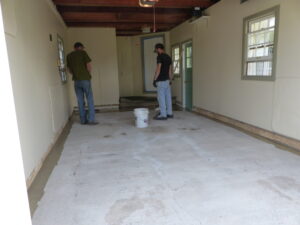
-
Working back to front.
-

-
Hello Garage crew Cleaning up excess
-

-
Applying sealer.
-

-
Curing
-
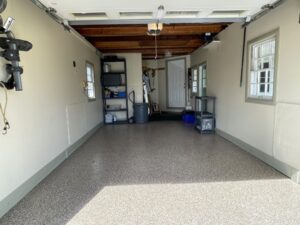
-
Garage Floor & Equip Inside.
by Winding Pathways | Sep 22, 2022 | (Sub)Urban Homesteading, Amphibians/Reptiles, Birds, Garden/Yard, Nature
We hadn’t seen either for a while but one September morning there they were. Mr. Toad and Ms. Wren.
Mr. Toad
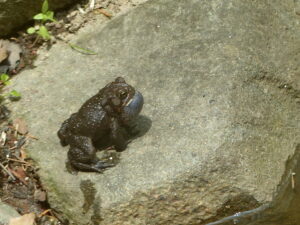
Toads sing loudly day and night.
All summer Mr. Toad contentedly lived beneath a tomato plant snacking on an occasional juicy bug. Ms. Wren meanwhile forayed about the yard snatching bugs and feeding her brood. In September Mr. Toad’s favorite tomato plant died back, probably tired after producing plenty of tasty fruits and no longer able to give Mr. Toad a worthy hiding place. And, after the babies fledged, Ms. Wren worked the prairie grasses and woods.
On that September morning, Rich noticed sweet potato leaves trembling a bit. He brushed aside the foliage and there was Mr. Toad out seeking breakfast.
The fall equinox is almost here. With it comes the short days and cool temperatures that make garden plants shrink. Mr. Toad is cold-blooded. Summer’s moist heat is to his liking, but before the cold comes, he must retire for the winter. So, down he goes, digging into the soil to find a place to snooze through the winter, no doubt dreaming about next summer’s juicy bugs under a new tomato plant.
We bid Mr. Toad adieu for the winter and said, “Thanks for helping with our gardening. See you next spring.”
Ms. Wren
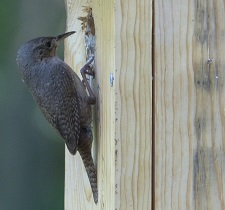
Checking the nest box.
Mr. Toad isn’t our only garden worker. Last winter we set up a wren house and by May Ms. Wren and her partner moved in. The couple raised two broods of ravenous babies in our garden. They enjoy the same fare as Mr. Toad but hunt more in our crop’s leaves instead of under them. The industrious parents spend nearly every daylight hour combing the garden and beyond for insects to feed their chicks.
Our last brood of garden wrens fledged in mid-August but stuck around a while. The family hunts insects in the woods behind the house but by the fall equinox they’ll get the urge to hop on a north wind some night and head south. When we’re shoveling snow, they’ll be snacking on bugs in a warm place.
Parting is Sweet Sorrow When Mr. Toad and Ms. Wren Bid Us Adieu
It’s hard to tell exactly when our wrens leave. Sometimes they linger into October but eventually one of us will say, “I haven’t seen or heard a wren for a while.” Yup, they’ve left for the season. We also bid them adieu and say, “Come back. See you next spring.” We miss Mr. Toad and Ms. Wren for the good work they do and for knowing we provide safe homes for them. We will put up wren boxes come March of next year and search for Mr. Toad sometime when the ground thaws.
About the Equinox
The Fall (autumnal) equinox is on or near September 21st. It’s one of two days when the sun crosses the celestial equator and every place on earth receives approximately 12 hours of daylight and 12 hours of darkness. The other is around March 21, the Vernal equinox. After the fall equinox the dark hours push daylight away until December 21 when days again begin to lengthen in the Northern Hemisphere. Plants and animals are super sensitive to day length and more aware of slight changes than most people.
by Winding Pathways | Sep 15, 2022 | (Sub)Urban Homesteading, Birds, Garden/Yard, Mammals, Nature, Pests
Guest Blog by Jackie Hull,
in the foothills of Virginia
Bears Barely Tolerable Behavior
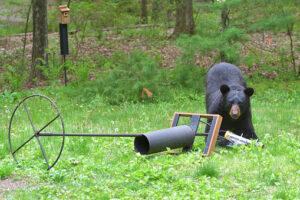
Bear Raiding Feeders
Well, the bear did it again. It tore up some of the spindles on the porch railing, tipped over a couple of the vegetable pots, and yanked a six-foot portion of our picket fence off the posts. All this to remind me that I should not feed the birds this time of year. It’s May.
So what to do but put away all the feeders? Maybe I can try again in the fall when bears retreat to the dens for their winter snooze.
This pretty much gave me great moments of sadness especially since I’ve had to shed other favorite activities.
Bird Antics Bring Joy
But today was a day of great surprises. My beautiful main stays, the birds, were everywhere. As I sat in the kitchen peering out the window, I spotted the adult turkeys poking their heads above the uncut hay. I could feel their parental thoughts “The coast is clear so keep scrambling forward.” The chicks were not seen but definitely there. A goldfinch zipped over them. Then I saw two wood thrashers near the holly tree scavenging for insects. Oh, my look how that crow struts!
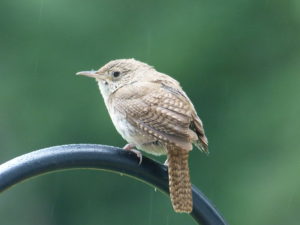
Wrens are Chatterers
Listen, that’s the wren by the back door. She keeps chattering to remind me she built her condo in the hanging planter. Then a flash of bright red caught my eye as I walked onto the porch. It’s a cardinal. Then the female house finch flicked from her nest over the front door light. She doesn’t like me stepping onto the porch. She is quite timid.
Even though the feeders have been down for nearly two months, the birds have kept their vigil at my country home much to my delight. They are in the trees, along the lane, and in the hayfield. What a great day!
by Winding Pathways | Sep 8, 2022 | (Sub)Urban Homesteading, Birds, Nature
Sometimes an animal’s name is misleading. Take the common nighthawks. It’s not a hawk and it doesn’t only fly at night. We often sit evenings on our back deck at Winding Pathways. In late summer 2022, we have been treated as dozens of aerial dancers – nighthawks – wheel overhead stalking mosquitoes and other insects. They can have all they can catch!
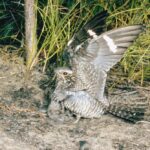
Common Nighthawks blend in with the ground. courtesy Free Photos
These birds are wonders. Closely related to whip-poor-wills, the brown feathers of the common nighthawk render them nearly invisible when resting in dry leaves or gravel during the day. They love evenings and wing overhead with their massive mouths open to snare tasty insects from the air.
Sometimes they pass just a few feet overhead. Occasionally they’re so high up that they are just fast-moving-turning-on-a-dime specks. Always they show distinct white stripes on the underside of their pointed wings.
Habits of Nighthawks
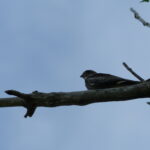
Resting nighthawk
We watched dozens of them in September 2022 and know that like many other migratory birds, they’ll join other birds for winter quarters in South America, so we enjoy them when we can. Daily we track bird migrations on the birdcast.info site. Nighthawks are one of the most widespread of North American birds, visible over farms, forests, and cities. Sometimes they even nest on gravel surfaced roofs of commercial buildings downtown and gravel areas of yards. We’ve caught glimpses of them resting on tree limbs. Watch the video to see many characteristics of nighthawks – their flight, sounds (listen for the “boom” of their wings), resting habits like sinking into the ground and yawning, and toward the end of this mini-documentary -the “waddle.” Fun!
Unfortunately, nighthawks have been declining about 1% a year since the 1960s. Why??? Pesticides, perhaps, reduce the insects that nighthawks feed on, and the loss of habitat. We don’t know for sure, but we enjoy watching their evening sky dance and hope people help them reverse their decline to continue their sky dance over much of the continent gobbling up insects.

















